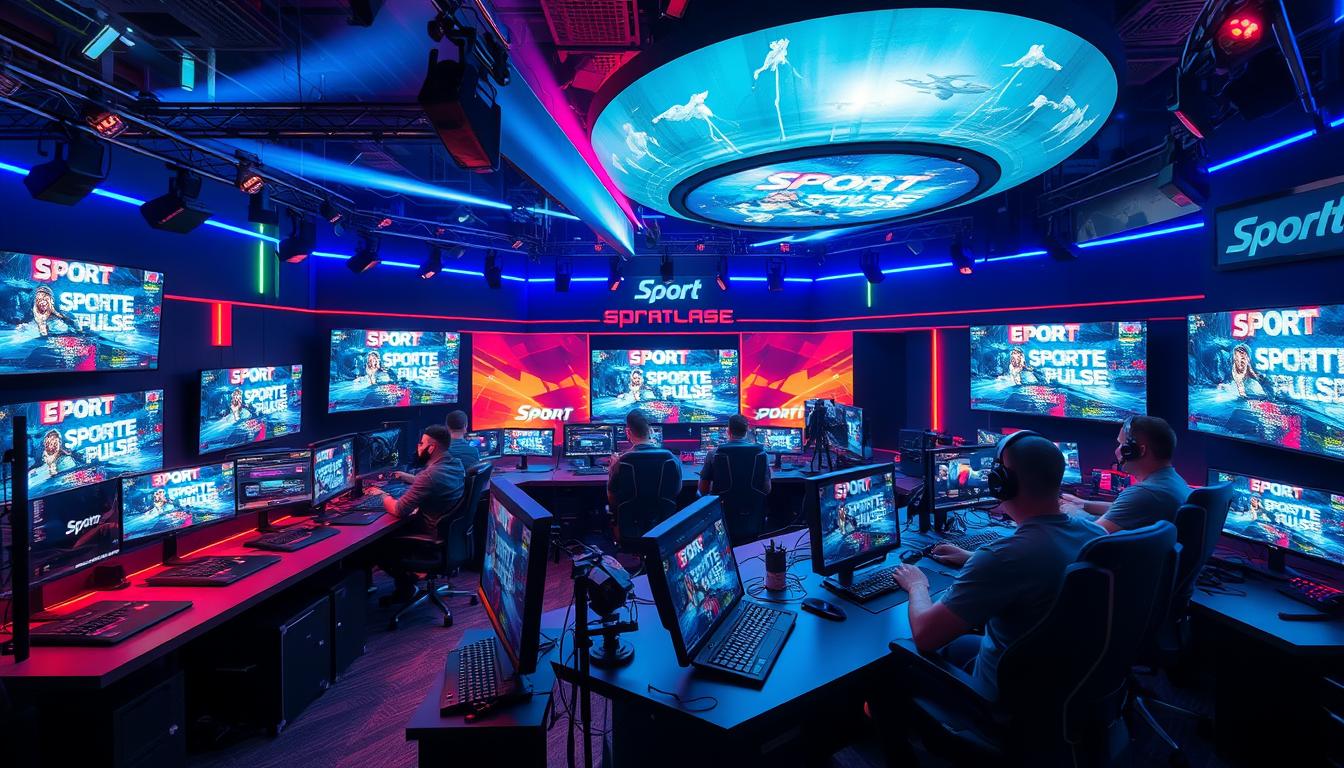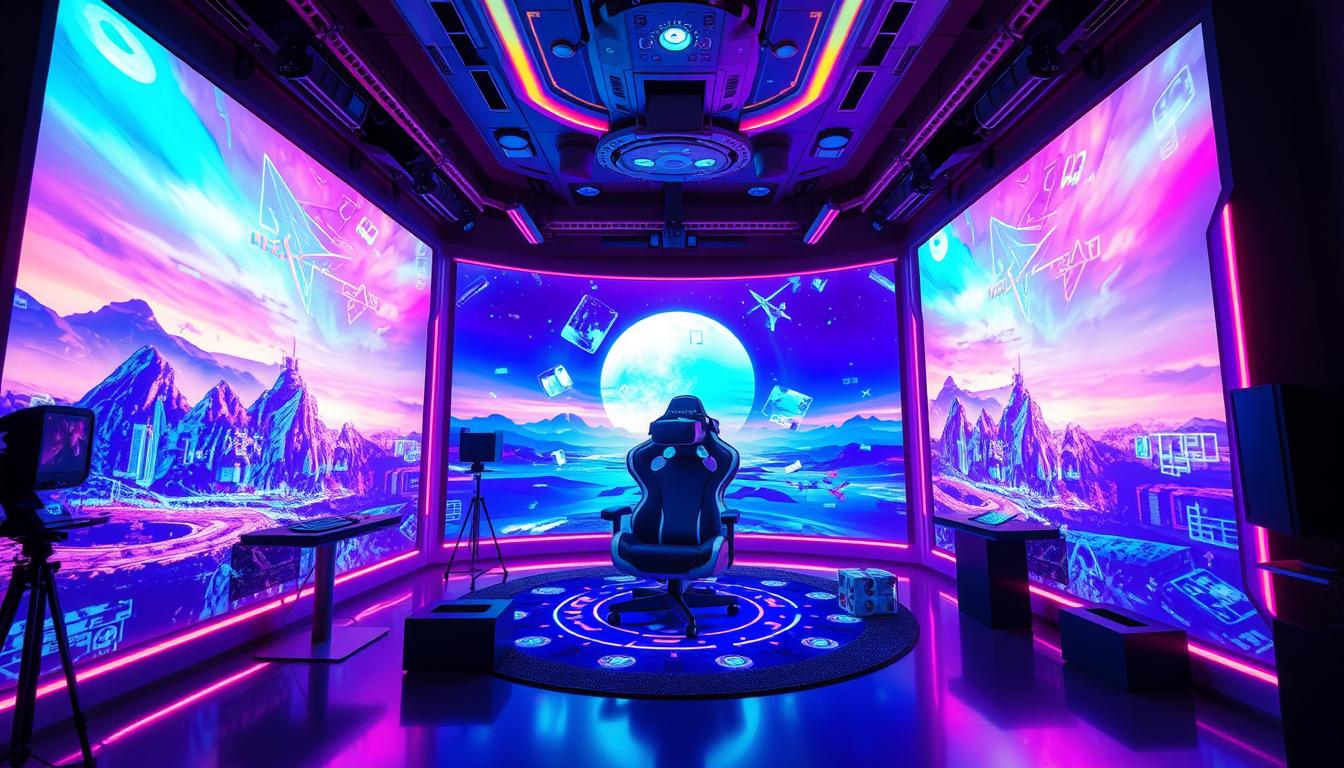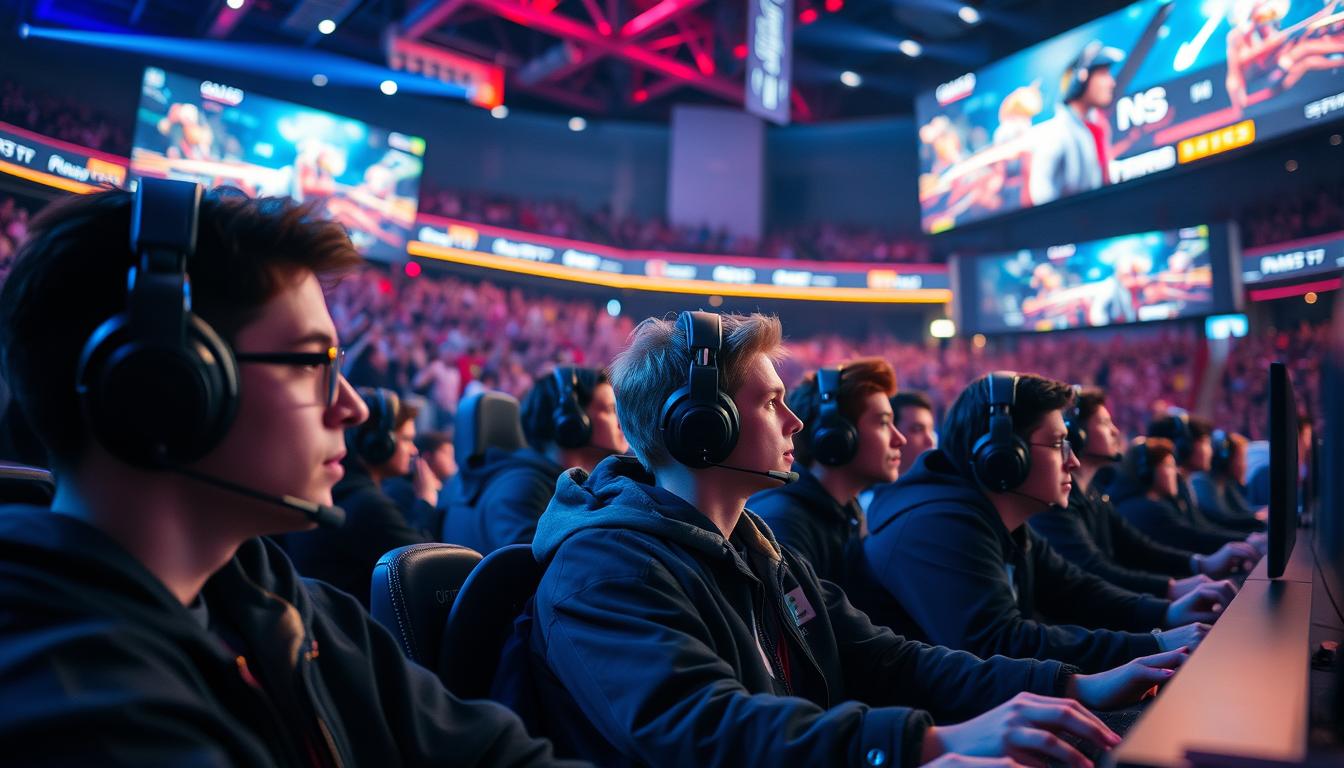We’re excited to take you behind the scenes of esports broadcasting. Here, competitive gaming meets high-tech production. We’ll explore the technology, talent, and strategies that power live events in the rapidly growing industry of esports broadcasting.
Esports and gaming today are all about trends, insights, and the future of competitive play. We’ll dive into what makes esports broadcasting tick. This includes the latest trends and insights, as well as the future of competitive play, focusing on live events and the behind the scenes efforts that make them successful.
As we explore the world of esports broadcasting, we’ll discuss the importance of live events. We’ll also talk about the technology used to produce them and the strategies that make them engaging for audiences. Our goal is to provide a complete look at the industry, including the role of esports broadcasting in shaping the future of competitive gaming.
Introduction to eSports Broadcasting
We’re committed to giving you an in-depth look at the esports broadcasting industry. We’ll cover the key players, trends, and technologies that are driving its growth. From live events to behind the scenes production, we’ll cover it all, providing insights and analysis that will help you understand the industry and its future.
Key Takeaways
- Esports broadcasting is a rapidly growing industry that combines competitive gaming with high-tech production.
- Live events are a key part of the esports broadcasting industry, requiring careful planning and execution.
- The behind the scenes efforts of esports broadcasting are just as important as the live events themselves.
- Esports broadcasting is driven by the latest trends and insights in competitive gaming.
- The industry is expected to continue growing in the coming years, with new technologies and innovations emerging all the time.
- Understanding the technology, talent, and strategies that power esports broadcasting is key to appreciating the industry and its future.
Understanding the eSports Broadcasting Landscape
The world of eSports broadcasting is growing fast. It’s now a big part of popular culture. Live events attract huge crowds, and production setup is key to quality broadcasts. New event technology makes watching games more exciting than ever.
More live events are happening, from small online tournaments to big competitions. These need special production setup and the latest event technology. This makes watching games fun for everyone. Teams, leagues, and platforms like the League of Legends Championship Series and the Overwatch League are leading the way.
- Online tournaments
- LAN (Local Area Network) events
- Stadium-filled competitions
These events help the eSports industry grow. Event technology is key to making watching games better. As we keep exploring eSports broadcasting, live events and production setup will keep being important for success.
Technical Aspects of Broadcasting
Technical aspects are key in eSports broadcasting. We use top-notch cameras, microphones, and lighting for the best coverage. Our team picks and sets up this gear to catch every action moment.
It’s not just about the equipment. Live streaming techniques are also important. They help us reach viewers worldwide. Event coverage makes sure our viewers get a full and exciting experience.
Our technical team focuses on a few main things:
- Keeping connections stable to avoid lag or breaks
- Picking the right equipment for each event
- Using live streaming techniques to keep our audience engaged
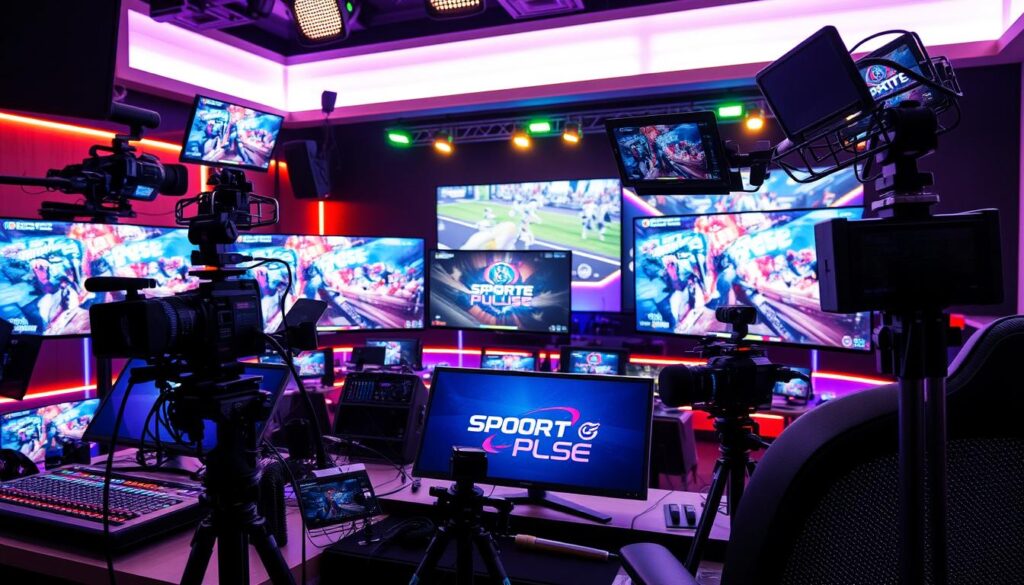
We aim to deliver a top-notch broadcast that meets our viewers’ expectations. Whether it’s a small tournament or a big event, our team works hard. We use our broadcasting equipment, live streaming techniques, and event coverage to give the best experience.
Behind the Scenes: The Production Team
When it comes to event management, we know how key a good team is. Our team is the heart of every broadcast, working hard behind the scenes to make sure you have a great view.
Good event coordination is key on event day. Every team member is important, from directors and producers to technicians and commentators. We make sure event management is top-notch for a great experience for our viewers.
To get this done, we focus on behind the scenes work. This includes teamwork and clear communication. This way, we can handle any problems fast, making our event coordination and event management smooth and effective.
Roles Within the Production Crew
- Directors and producers oversee the entire production
- Technicians handle the technical aspects of the broadcast
- Commentators provide expert analysis and commentary
Coordination on Event Day
Our team works together to make sure the broadcast goes smoothly. Each member plays a big part in the event coordination process.
Preparing for a Live eSports Event
Getting ready for a live eSports event is key. A good production setup is vital for a smooth and fun experience. It’s all about the event technology and broadcasting gear for top-notch sound and visuals.
Our team starts with pre-production planning. This includes scheduling, budgeting, and the event’s concept. We also focus on setting up the venue and equipment. This ensures the broadcast quality is top-notch.
Some important steps in our prep are:
- Working with event staff and players for a smooth event
- Doing sound and video checks for quality broadcasting
- Getting legal clearances to protect everyone involved
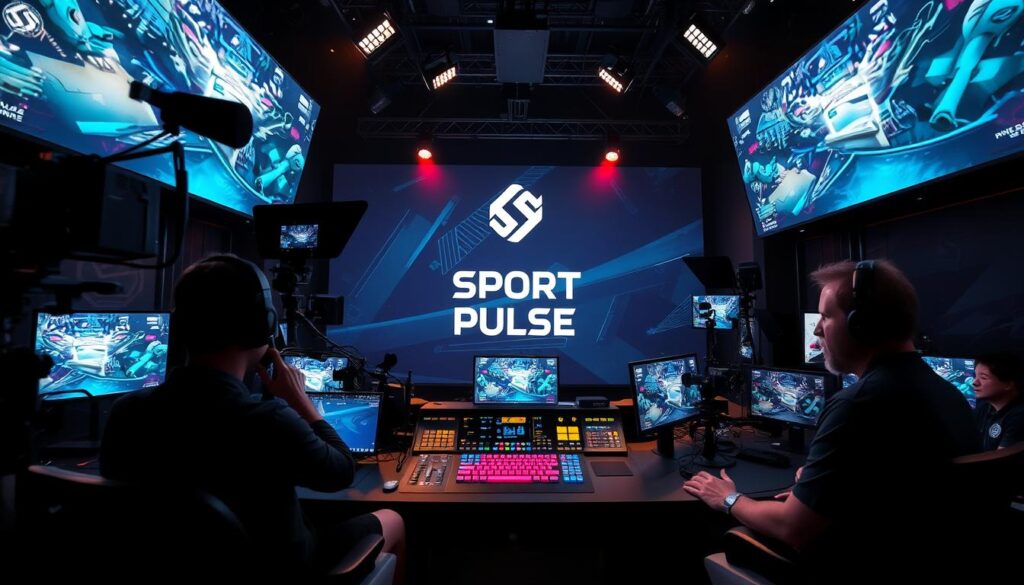
By focusing on these details and using the best equipment, we aim to make the event unforgettable. It’s all about creating an immersive experience for the audience.
| Aspect of Preparation | Importance |
|---|---|
| Pre-production planning | High |
| Setting up the venue and equipment | High |
| Ensuring legal clearances and compliance | High |
The Role of Commentators and Analysts
Commentators and analysts are key in live events. They bring the game to life with their knowledge and excitement. Choosing the right voices is critical for a great broadcast.
They prepare by studying the teams and players. They also practice to deliver smoothly. Live streaming lets them share analysis in real-time. This keeps viewers informed and engaged.
- Researching the teams and players to gain a deeper understanding of their strengths and weaknesses
- Practicing delivery to ensure a smooth and engaging broadcast
- Staying up-to-date with the latest developments and trends in the game
By following these steps, commentators can deliver top-notch live events. They use live streaming and event coverage to keep the audience interested.
Their main goal is to connect with the audience. They share their insights to make the event special. This makes live events stand out from other entertainment.
Audience Engagement and Interaction
Exploring eSports broadcasting, we find it key to engage the audience. Good event planning is vital for a great viewing experience. Our team works hard to make sure everything goes smoothly.
We use social media to connect with our viewers. We share updates and encourage them to interact. This builds a community around our events, which is essential for their success. Community building is a continuous effort that needs creativity and dedication.
Here are some ways we engage our audience:
- Live polls and viewer feedback, which provide real-time interaction and make the audience feel like they are part of the event
- Social media contests and giveaways, which encourage audience participation and reward their engagement
- Behind-the-scenes content, which gives our audience a glimpse into the planning and execution of our events
Our aim is to build a loyal fan base. We want to give our viewers an unforgettable experience. Effective event planning, management, and behind-the-scenes work are key to achieving this.
Trends in eSports Broadcasting
We’re seeing big changes in esports broadcasting, with new trends and tech popping up all the time. These changes affect how we enjoy live events and what goes on behind the scenes. The mix of esports broadcasting with new tech is changing how we watch live events.
Some key trends shaping esports broadcasting include:
- Innovations in virtual reality (VR) and augmented reality (AR), which offer immersive experiences that bring viewers closer to the action.
- The shift towards interactive broadcasting, allowing for more engagement and participation from the audience.
- Changes in viewer preferences, with broadcasters needing to adapt to meet the evolving demands of their audience.
Now, fans can interact with live events through interactive platforms, making the experience more dynamic. As we look to the future, it’s key to stay ahead and use these trends in our strategies.
Emerging Technologies and Their Impact
Exploring emerging technologies shows they’ll be key in shaping esports broadcasting’s future. With more live events and behind the scenes content, we’ll see more VR, AR, and interactive broadcasting.
By embracing these trends and technologies, we can make viewing more immersive and engaging. This will help esports broadcasting grow and succeed.
Monetization Strategies for eSports Events
Exploring eSports, we find many ways to make money. Good event planning is key to earning more. Sponsorships and partnerships with brands are on the rise. Companies see the eSports audience as valuable.
Live streaming is now a big part of eSports. It lets fans watch from anywhere. This opens up new ways to make money, like subscriptions and pay-per-view. Some main ways to make money include:
- Sponsorships and brand partnerships
- Merchandise and ticket sales
- Subscription models and pay-per-view services
These strategies help events make money and keep fans happy. We need to keep finding new ways to make money. But we must also focus on good event planning.
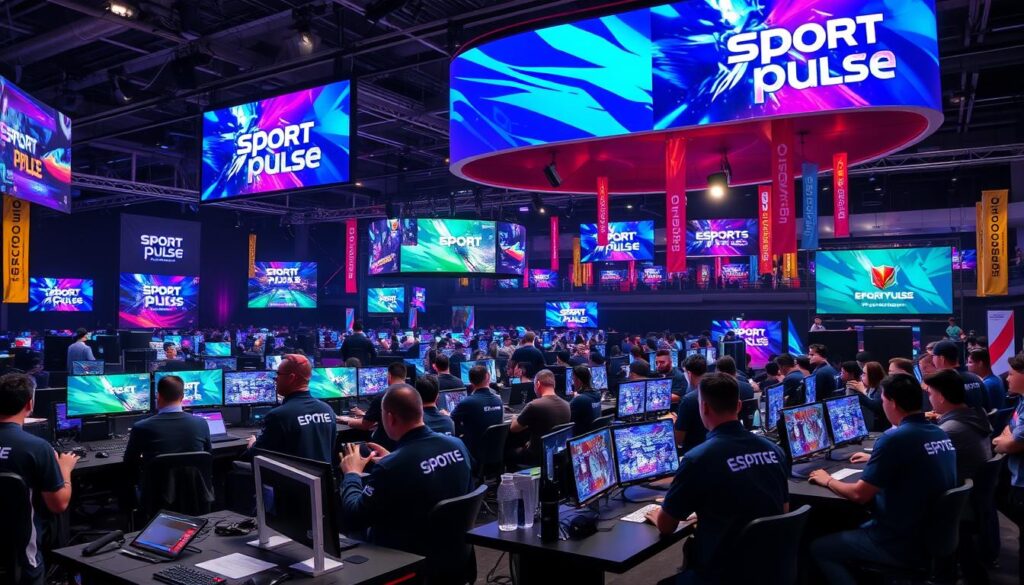
This way, eSports can grow and succeed. Fans will have a great experience, whether watching live or online. Success comes from well-planned events that please everyone.
The Future of eSports Broadcasting
Looking ahead, eSports broadcasting will see big changes. We expect more viewers, events, and investment. This will boost growth in esports broadcasting and open up new jobs for behind the scenes experts. New tech like VR and AR will make watching games even more exciting.
Some trends will shape eSports broadcasting’s future:
- More use of virtual reality and augmented reality for interactive experiences
- More live events in new places and for more people
- More focus on behind the scenes work for better broadcasts
To tackle challenges like keeping viewers interested and solving tech problems, we must innovate and team up. By understanding what our audience wants, we can keep eSports broadcasting exciting. As the field grows, we’ll see new chances for live events, behind the scenes work, and broadcasting itself.
Enhancing Viewer Experience
We aim to give our viewers the best experience. This starts with the quality of our broadcast. We use advanced live streaming techniques to make our coverage engaging and immersive. We also invest in top-notch broadcasting equipment for a clear visual experience.
Several factors help improve the viewer experience:
- High-definition video and audio
- Interactive features, such as live chat and polls
- Unique viewing environments, including virtual reality and augmented reality options
By adding these elements, we make our experience more engaging and memorable. As we keep improving our live streaming, we aim to offer an even more immersive experience. This will make our events more enjoyable and interactive for everyone.
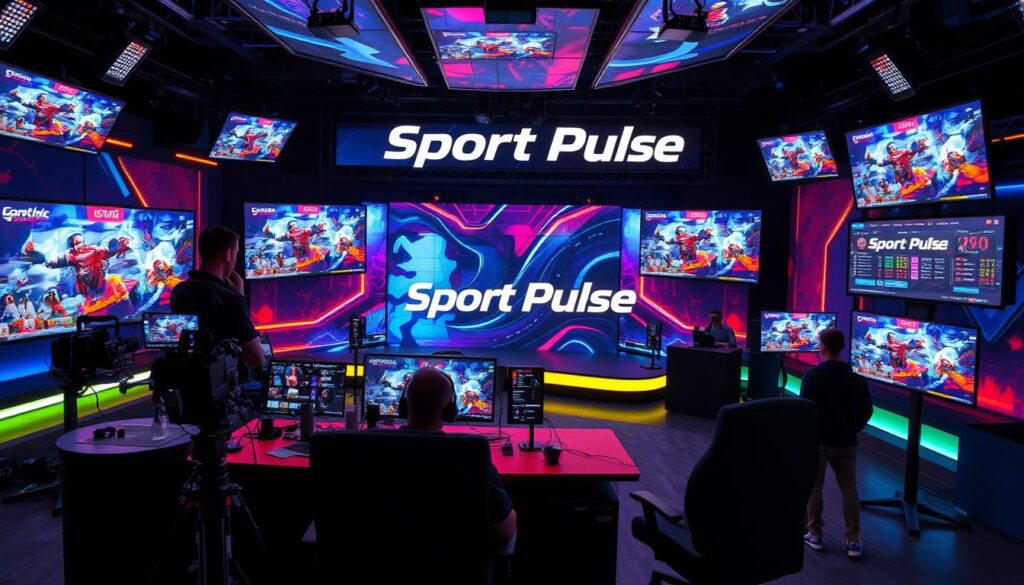
We want every event to feel unique and special. We believe focusing on broadcast quality and adding interactive features helps us achieve this. By using the latest equipment and staying current with trends, we aim to give our viewers the best experience.
Case Studies of Successful eSports Broadcasts
We’ve looked into several successful eSports broadcasts. We found key factors that make them stand out. These include event management, event coordination, and behind the scenes planning.
The League of Legends World Championship is a great example. It attracts big crowds and gets high praise for its quality. Its success comes from careful planning and coordination of everything involved.
Noteworthy Events in Recent History
The Fortnite World Cup and the Dota 2 International are also successes. They show how important behind the scenes work is. This includes rehearsals, sound checks, and planning for unexpected issues.
Some key takeaways from these examples are:
- Good event management is key for success
- Pay attention to the small details in event coordination
- Planning and rehearsals are vital for a smooth event
Lessons Learned from Big Brands
Big names like Riot Games and Epic Games have also joined eSports. They bring their marketing and production skills. By studying their methods, we can learn how to manage and coordinate events well.
| Event | Key Factors | Outcome |
|---|---|---|
| League of Legends World Championship | Meticulous event management, careful planning and coordination | High production quality, large audience |
| Fortnite World Cup | Behind the scenes planning, rehearsals, sound checks | Smooth and enjoyable experience for participants and viewers |
| Dota 2 International | Effective event coordination, attention to detail | High-quality broadcast, large audience |
Our Call to Action: Join the eSports Revolution
We’ve explored the exciting world of eSports broadcasting. Now, we invite you to join this fast-growing industry. Whether you love watching games, want to broadcast them, or connect with the eSports community, there’s a place for you.
How to Get Involved in Broadcasting
There are many roles in eSports broadcasting, from live commentary to event management. If you’re passionate about gaming, this is your chance to shine. Start by looking into different careers and dive into the world of competitive gaming.
Opportunities for Aspiring Broadcasters
Are you dreaming of becoming a broadcaster? The eSports world needs your creativity and voice. You could be a commentator, analyst, or host, reaching fans globally. Work with teams, event organizers, and production crews to improve your skills and leave your mark.
The Importance of Supporting the eSports Community
Supporting the eSports community is key to its growth. Attend events, connect with creators, and celebrate the industry’s innovation. By building a strong community, we can take eSports broadcasting to new levels. Together, we can unite people worldwide through their love of gaming and live events.
